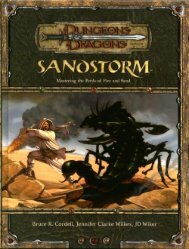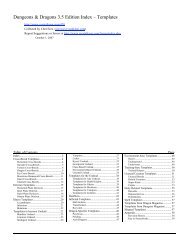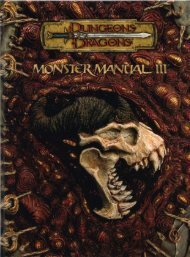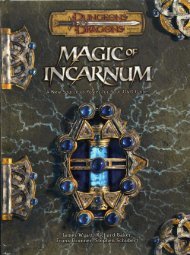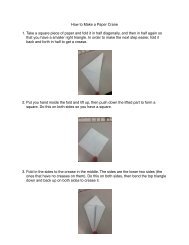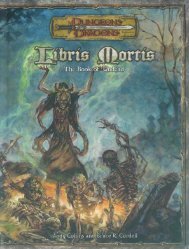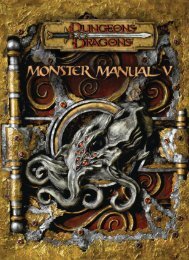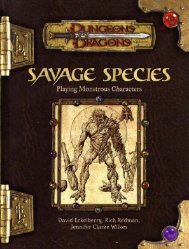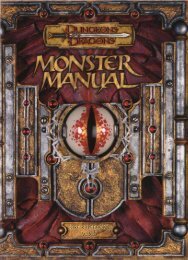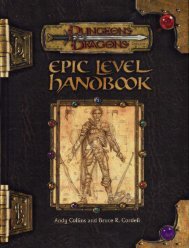CHAPTER 7EQUIPMENTAND MAGIC166another target <strong>of</strong> the thrower’s choice. The second target mustbe adjacent to the original target (no more than 5 feet away).The thrower immediately makes a second attack roll for theskiprock against the new target, with an attack bonus 2 lowerthan that <strong>of</strong> the initial attack.Although they are thrown weapons, skiprocks are treatedas ammunition for the purposes <strong>of</strong> drawing them, craftingmasterwork or otherwise special versions <strong>of</strong> them, and whathappens to them after they are thrown.Skiprocks can be used as sling bullets, but using a skiprock’sricochet ability in conjunction with a sling requires takingthe Exotic Weapon Pr<strong>of</strong>iciency (war sling) feat.Sword, Elven Courtblade: These exotic swords seemimpossibly long and thin, tapering to a needlelike point.One edge <strong>of</strong> the blade is sharpened along its entire length,and the opposite edge is sharpened only for the final quarternear the tip. A courtblade has a basket-shaped hilt (usuallymade to resemble leaves and vines), a long grip, and a heavypommel. The weapon is intended for thrusting attacks, butthe wielder can slash with it as well.A character with the Exotic Weapon Pr<strong>of</strong>iciency (elven courtblade)feat finds the weapon well suited for quick feints andthrusts. A character can use an elven courtblade in conjunctionwith the Weapon Finesse feat, applying her Dexterity bonus(if any) to melee attacks she makes with the weapon, thoughit remains a two-handed weapon and not a light weapon.Characters pr<strong>of</strong>icient with the elven courtblade may treat it asa greatsword for the purpose <strong>of</strong> any <strong>of</strong> the following feats: GreaterWeapon Focus, Greater Weapon Specialization, ImprovedCritical, Weapon Focus, and Weapon Specialization.Sword, Elven Lightblade: This rapierlike exotic weapon isthe size <strong>of</strong> a short sword but weighs only as much as a dagger.Dexterous elf fighters and rogues favor it. Its thin, flexibleblade slips easily into the seams <strong>of</strong> armor or between the ribs<strong>of</strong> a foe. Some elf nobles carry a lightblade—<strong>of</strong>ten decoratedwith intricate filigree and tiny gemstones—as a sign <strong>of</strong> theirstation, even if they aren’t pr<strong>of</strong>icient in its use.Characters pr<strong>of</strong>icient with the elven lightblade may treatit as a rapier or a short sword for the purpose <strong>of</strong> any <strong>of</strong> thefollowing feats: Greater Weapon Focus, Greater WeaponSpecialization, Improved Critical, Weapon Focus, andWeapon Specialization.Sword, Elven Thinblade: This rapierlike exotic weapon isthe size <strong>of</strong> a longsword but much lighter. Like the lightblade,it is favored by dexterous elf fighters and rogues.A character can use the Weapon Finesse feat to apply hisDexterity modifier instead <strong>of</strong> his Strength modifier to attackrolls with an elven thinblade.Characters pr<strong>of</strong>icient with the elven thinblade may treatit as a rapier or a longsword for the purpose <strong>of</strong> any <strong>of</strong> thefollowing feats: Greater Weapon Focus, Greater WeaponSpecialization, Improved Critical, Weapon Focus, andWeapon Specialization.War Sling: This exotic weapon is a heavy sling used witha special sidearm throw to hurl a skiprock (see above) withdeadly power. Without skiprock ammunition, a war sling istreated as a normal sling and deals the appropriate damagewhen used to throw normal sling bullets or stones.A user pr<strong>of</strong>icient with both the skiprock and the war slingcan ricochet a sling-thrown skiprock just like a hand-thrownskiprock; see the skiprock description, above.WEAPON MODIFICATIONSBow, Elvencraft: One <strong>of</strong> the biggest problems facing anyarcher is deciding what to do when a foe gets within meleereach. Does one stand fast and take the consequences (whichcan prove painful if not deadly), fall back (not always practical),or drop the bow and draw a melee weapon (inconvenientat best). Elf bowyers have made the choice somewhat lessdifficult by crafting bows that can stand up to melee combat.Thanks to elven ingenuity, these weapons work just as wellas melee weapons as they do as ranged weapons.An elvencraft bow is thicker and heavier than a normalbow. An elvencraft shortbow functions as a club whenwielded as a melee weapon. An elvencraft longbow functionsas a quarterstaff when wielded as a melee weapon. The wielderincurs no penalty on attack rolls when using an elvencraftbow as a melee weapon.A character wielding an elvencraft bow can freely interchangemelee and ranged attacks during the same round. When wieldingan elvencraft bow, the user threatens the squares aroundhim no matter how he last used the weapon.Magical enhancements to an elvencraft bow only affect itsuse as a bow. Enhancements to the melee capabilities <strong>of</strong> theweapon must be added separately.An elvencraft bow costs 300 gp more than a normal bow.Blade, Close Fighting: Elves love swordplay, but evenelves recognize that a sword isn’t always an ideal weapon.They developed the close fighting blade for times when theymust fight in spaces too constricted for true swordplay.A close fighting blade is simply a knifelike blade concealedwithin the hilt or haft <strong>of</strong> a one-handed or larger meleeweapon. Pressing a catch in the hilt (a free action) releasesthe spring-loaded blade, which extends and locks into placeprotruding from the pommel or butt <strong>of</strong> the larger weapon.A close fighting blade is the equivalent <strong>of</strong> a dagger inall respects, except that it is a bit more awkward to use. Itis most useful in situations where the wielder is suddenlyrendered incapable <strong>of</strong> using her normal melee weapon,such as when she is grappling or being swallowed by somehulking monster.While a close fighting blade is extended, the wielder takesa –2 penalty on attack rolls, both with the close fighting bladeand with the weapon that normally conceals it (which becomesmore awkward to use). Retracting a close fighting blade is theequivalent <strong>of</strong> sheathing a weapon (a move action).Even with the hidden blade extended, a weapon with aclose fighting blade is not a double weapon. The user canemploy either the main weapon or the extended blade, butnot both in the same round.A close fighting blade must be enchanted separately fromthe weapon in which it is housed.
Elves typically include close fighting blades in longswordsor rapiers for their own use. Elf wizards sometimes carryquarterstaffs that contain close fighting blades. In some areas,elves fashion battleaxes, heavy maces, or similar one-handedweapons with close fighting blades, though these items areusually sold to other races.Adding a close fighting blade to an existing weapon, orincluding one as part <strong>of</strong> a new weapon, costs 100 gp.ARMORElves are famous for lightweight armor that provides good protectionand considerable freedom <strong>of</strong> movement. Unlike dwarves,who typically innovate in armorcrafting by inventing newexotic types <strong>of</strong> armor, elves learn to use the materials available tothem—<strong>of</strong>ten augmenting them through alchemy or the simpleapplication <strong>of</strong> skill—to create extraordinarily supple and flexiblesuits <strong>of</strong> armor. Indeed, the armor popularly called elven chain isnothing but a regular suit <strong>of</strong> chainmail made from mithral.Over the years, these inventions have spread to halfling andraptoran armorsmiths, whose customers typically have similarneeds regarding a suit <strong>of</strong> armor’s weight and encumbrance.Each suit <strong>of</strong> armor described on Table 7–2 represents anexisting kind <strong>of</strong> armor from the Player’s Handbook with aspecial material used in its creation. These special materialsare detailed later in this chapter (except for mithral, which isdescribed on page 284 <strong>of</strong> the Dungeon Master’s Guide).ARMOR MODIFICATIONSIn addition to their innovations with special armor materials,the races <strong>of</strong> the wild have also created armor modificationstailored to their needs.Forestwarden Shroud: Elves invented this lightweightset <strong>of</strong> tunic and leggings, though it was quickly adopted byrangers and similar characters <strong>of</strong> all races.A forestwarden shroud is worn over a suit <strong>of</strong> armor. It canbe incorporated into any suit <strong>of</strong> armor during creation, or itcan be added later. Its slick surface allows branches and leavesto slide easily across it, negating the effect that undergrowthand heavy undergrowth has on the wearer’s Tumble and MoveSilently checks (see Forest Terrain, page 87 <strong>of</strong> the DungeonMaster’s Guide).A forestwarden shroud costs 100 gp and adds 2 pounds tothe weight <strong>of</strong> a suit <strong>of</strong> armor.Netcutter Spikes: The raptorans developed netcutterspikes to help them avoid becoming immobilized in combat.Netcutter spikes are slightly longer than regular armor spikesand have X-shaped cross-sections. Each spike is sharpenedalong all four edges.Netcutter spikes function just like armor spikes (seepage 124 <strong>of</strong> the Player’s Handbook). In addition, a characterpr<strong>of</strong>icient with the armor worn gains a +4 circumstance bonuson Strength checks or Escape Artist checks made to escapefrom a net, a web spell, or a similar entangling effect.Illus. by W. EnglandCHAPTER 7EQUIPMENTAND MAGICLeft to right: forestwarden shroud, leafweave armor, netcutter spikes, thistledown suit, wildwood armor167
- Page 2:
C R E D I T SD E S I G NSKIP WILLIA
- Page 7 and 8:
no elf could predict which memory w
- Page 9 and 10:
premium. Thus, each individual can
- Page 11 and 12:
The elves have raised one form of e
- Page 13 and 14:
do spend time away from one another
- Page 15 and 16:
espects during this time, and those
- Page 17 and 18:
Stores Master: Charged with keeping
- Page 19 and 20:
would be the birthright of any full
- Page 21 and 22:
of feet above the forest floor. Mos
- Page 23 and 24:
Cleric Training: More than any othe
- Page 25 and 26:
ELF HISTORYAND FOLKLOREThe elves cl
- Page 27 and 28:
along with her son Hionyron, who wa
- Page 29 and 30:
and return her to her people.” In
- Page 31 and 32:
Table 1-3: Suffixesd% Suffix Meanin
- Page 34:
CHAPTER 1ELVES34tri-level tree home
- Page 37 and 38:
Illus. by C. Lukacsurious and activ
- Page 39 and 40:
the reason for the farmer’s hospi
- Page 41 and 42:
Halflings make a visitor feel welco
- Page 43 and 44:
Halflings are usually pleasant trav
- Page 45 and 46:
Halflings are as eager to experienc
- Page 47:
A chief or elder heads each clan, c
- Page 50 and 51:
CHAPTER 2HALFLINGS50away from their
- Page 52 and 53:
CHAPTER 2HALFLINGS52Illus. by S. Wo
- Page 54 and 55:
CHAPTER 2HALFLINGS54to tell how lon
- Page 56 and 57:
CHAPTER 2HALFLINGS56the underbrush
- Page 58 and 59:
CHAPTER 2HALFLINGSIllus. by T. Baxa
- Page 60 and 61:
CHAPTER 2HALFLINGS60Donta muden sit
- Page 63 and 64:
and one or more bedrooms. All have
- Page 65 and 66:
Illus. by C. Lukacshe cliff-dwellin
- Page 67 and 68:
Personality: Raptorans have a reput
- Page 69 and 70:
PSYCHOLOGYSome outsiders who have h
- Page 71 and 72:
for making a point through a logica
- Page 73 and 74:
flock for debate, sometimes invitin
- Page 75 and 76:
its eggs. At such times, they toler
- Page 77 and 78:
THE RAPTORAN PANTHEONThe typical ra
- Page 79 and 80:
Prayers: Prayers to the Stormfather
- Page 81 and 82:
“Welcome, friend,” said a human
- Page 83 and 84:
year since, and they share the care
- Page 85 and 86:
D: Domain spell. Domains: Protectio
- Page 87 and 88:
characteristics are summarized in t
- Page 90 and 91:
CHAPTER 3RAPTORANS90Authority Figur
- Page 92 and 93:
CHAPTER 4OTHERRACES92a humanlike ra
- Page 94 and 95:
CHAPTER 4OTHERRACES94ment, finding
- Page 96 and 97:
CHAPTER 4OTHERRACES96Illus. by S. B
- Page 98 and 99:
Table 4-1: The CentaurHit Base Atta
- Page 100 and 101:
CHAPTER 4OTHERRACES100nomadic gnoll
- Page 102 and 103:
Table 4-2: The GnollBase Fort Ref W
- Page 104 and 105:
CHAPTER 4OTHERRACES104of the humano
- Page 106 and 107:
CHAPTER 4OTHERRACESsneak attack, bu
- Page 108 and 109:
CHAPTER 5PRESTIGECLASSES108Shadowda
- Page 110 and 111:
CHAPTER 5PRESTIGECLASSESIllus. by W
- Page 112 and 113:
CHAPTER 5PRESTIGECLASSES112the foll
- Page 114 and 115:
CHAPTER 5PRESTIGECLASSES114Entry Re
- Page 116 and 117: CHAPTER 5PRESTIGECLASSESIllus. by J
- Page 118 and 119: CHAPTER 5PRESTIGECLASSESLUCKSTEALER
- Page 120 and 121: CHAPTER 5PRESTIGECLASSESIllus. by J
- Page 122 and 123: CHAPTER 5PRESTIGECLASSESEL 11: Kuly
- Page 124 and 125: CHAPTER 5PRESTIGECLASSES124spellcas
- Page 126 and 127: CHAPTER 5PRESTIGECLASSES126save bon
- Page 128 and 129: CHAPTER 5PRESTIGECLASSESmore than o
- Page 130 and 131: CHAPTER 5PRESTIGECLASSES130raptoran
- Page 132 and 133: CHAPTER 5PRESTIGECLASSES132Table 5-
- Page 134 and 135: CHAPTER 5PRESTIGECLASSESfriendly—
- Page 136 and 137: CHAPTER 5PRESTIGECLASSESYou no long
- Page 138 and 139: CHAPTER 5PRESTIGECLASSES138small fe
- Page 140 and 141: CHAPTER 5PRESTIGECLASSES140ranger.
- Page 142 and 143: CHAPTER 5PRESTIGECLASSESIllus. by T
- Page 144 and 145: CHAPTER 5PRESTIGECLASSESEncountersP
- Page 146 and 147: CHAPTER 6CHARACTEROPTIONS146Conditi
- Page 148 and 149: CHAPTER 6CHARACTEROPTIONS148If the
- Page 150 and 151: CHAPTER 6CHARACTEROPTIONSIllus. by
- Page 152 and 153: CHAPTER 6CHARACTEROPTIONSIllus. by
- Page 154 and 155: CHAPTER 6CHARACTEROPTIONSIllus. by
- Page 156 and 157: Table 6-3: Elf Ranger Racial Substi
- Page 158 and 159: Table 6-5: Halfling Druid Racial Su
- Page 160 and 161: CHAPTER 6CHARACTEROPTIONS160Table 6
- Page 162 and 163: Class SkillsRaptoran fighter substi
- Page 164 and 165: CHAPTER 7EQUIPMENTAND MAGICIllus. b
- Page 168 and 169: CHAPTER 7EQUIPMENTAND MAGICTable 7-
- Page 170 and 171: CHAPTER 7EQUIPMENTAND MAGICIllus. b
- Page 172 and 173: CHAPTER 7EQUIPMENTAND MAGICIllus. b
- Page 174 and 175: 2nd-Level Ranger SpellWoodland Veil
- Page 176 and 177: WOODLAND VEILIllusion (Glamer)Level
- Page 178 and 179: CHAPTER 8CAMPAIGNS INTHE WILD178THE
- Page 180 and 181: CHAPTER 8CAMPAIGNS INTHE WILDIllus.
- Page 182 and 183: CHAPTER 8CAMPAIGNS INTHE WILD182(lo
- Page 184 and 185: CHAPTER 8CAMPAIGNS INTHE WILD184Ski
- Page 186 and 187: CHAPTER 8CAMPAIGNS INTHE WILD186Tab
- Page 188 and 189: CHAPTER 8CAMPAIGNS INTHE WILDIllus.
- Page 190 and 191: CHAPTER 8CAMPAIGNS INTHE WILDIllus.
- Page 192: APPENDIX19261 Guards are needed to
- Page 195 and 196: 2THE CLIFFThe Rifinti dwelling lies
- Page 198 and 199: supplies for craftwork. Lamps fuele
- Page 200 and 201: Nae’fidrim: Female owl companion;
- Page 202 and 203: Creatures: A cleric is always on du
- Page 204 and 205: cloak of elvenkind, oil of magic we
- Page 206: aptoran contraries. If visitors can



